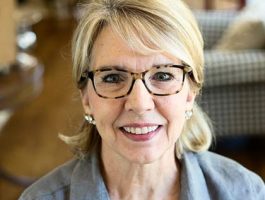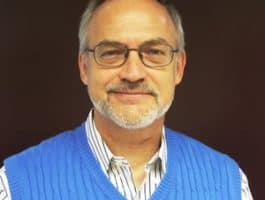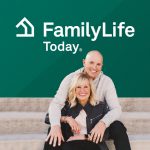
The Real First Thanksgiving
It's Plymouth, Massachusetts, and the Thanksgiving celebration is about to begin. Pilgrims adorned in black hats and buckles are sitting down to a bountiful feast with their new friends, the Wampanoag Indians. Before them is a table decked with turkeys, cranberry sauce, and pumpkin pie... This is the Thanksgiving we all imagine, but is this what really happened? Barbara Rainey and history professor Tracy McKenzie take us on a fascinating journey through history to shed light on the real first Thanksgiving and the intriguing people we call the Pilgrims.
Show Notes
About the Guest
-
It's Plymouth, Massachusetts, and the Thanksgiving celebration is about to begin. Pilgrims adorned in black hats and buckles are sitting down to a bountiful feast with their new friends, the Wampanoag Indians. Before them is a table decked with turkeys, cranberry sauce, and pumpkin pie... This is the Thanksgiving we all imagine, but is this what really happened? Barbara Rainey and history professor Tracy McKenzie take us on a fascinating journey through history to shed light on the real first Thanksgiving and the intriguing people we call the Pilgrims.
-

Barbara Rainey
After graduating from the University of Arkansas with a Bachelor of Arts degree in history, Barbara joined the staff of Cru® in 1971. With her husband Dennis, whom she married in 1972, the Rainey’s cofounded FamilyLife®, a ministry committed to helping marriages and families survive and thrive in our generation. Barbara is a frequent speaker and guest on FamilyLife Today®, FamilyLife’s award-winning nationally-syndicated daily radio broadcast. She is the author or coauthor of...more
Tracy McKenzie
Robert Tracy McKenzie (Ph.D., Vanderbilt University) is professor and chair of the department of history at Wheaton College, where he teaches courses in U.S. history, the Civil War and historiography. McKenzie is the author of two award-winning monographs: "One South or Many? Plantation Belt and Upcountry in Civil-War Era Tennessee" (Cambridge, 1994) and "Lincolnites and Rebels: A Divided Town in the American Civil War" (Oxford, 2009). He has also written numerous scholarly reviews and articles...more
History professor Tracy McKenzie and Barbara Rainey take us on a fascinating journey through history to shed light on the real first Thanksgiving and the intriguing people we call the Pilgrims.
The Real First Thanksgiving
Bob: One of the things that made the very first Thanksgiving different than our modern celebration of Thanksgiving Day—the Pilgrims, probably, went to church. Here is Professor Tracy McKenzie.
Tracy: The Pilgrims actually believed that the Scripture authorized irregular kinds of holy days—either of humiliation and fasting in a moment of great crisis or thanksgiving in a moment of celebration of God’s provision. What they called, actually, a thanksgiving holy day would not have involved games / it would not have involved a lot of celebration. It would have been a very solemn kind of church gathering.
Bob: This is FamilyLife Today for Friday, November 24th. Our host is the President of FamilyLife®, Dennis Rainey, and I’m Bob Lepine. We just celebrated Thanksgiving. There are a lot of things you don’t know about the very first Thanksgiving—and maybe some things you think you know that aren’t really so. We’ll talk more today about the holiday we just celebrated.
1:00
Stay with us.
And welcome to FamilyLife Today. Thanks for joining us on the Friday edition. I want you to complete this sentence: “Thanksgiving dinner would not be Thanksgiving dinner without turkey and…”
Dennis: Well, traditionally—here in America—you’ve got to say, “…football.” I mean—
Bob: See, I’m still at the table—I’m still thinking, “…food.” [Laughter]
Dennis: —“…food.”
Bob: You’re going right to—I was thinking pecan pie or pumpkin pie. See, I’ve never liked pumpkin pie. So, it was always pecan pie at our house.
Dennis: Let’s ask Barbara. How would you have finished the sentence?
Bob: “Turkey and…”
Barbara: —“…dressing.”
Bob: Yes; see—we did mashed potatoes instead of dressing because I never liked—
Barbara: That’s more northern—it’s the southern thing to do the cornbread dressing—and, because my mother is southern, that’s what we had.
Bob: I’m just wondering if the Pilgrims had any of this stuff when they had the first Thanksgiving—you know, if they had stuffing or—I know they didn’t have football.
Barbara: I don’t think they did—[Laughter]
Dennis: Let’s ask—
Barbara: —not like we think of it.
Dennis: Let’s ask our guest professor—
Bob: Yes.
Dennis: —who joins us, here, on FamilyLife Today.
2:00
Dr. Tracy McKenzie joins us again. Welcome back, Tracy.
Tracy: Glad to be here, Dennis.
Dennis: He is Professor and Chair of the Department of History at Wheaton College, and he and his wife live north of Chicago. He is an expert—he has written this book called The First Thanksgiving.
Bob: In fact, you can get a half credit for listening to today’s program. [Laughter] You just write to me, and I’ll go ahead and send you the papers; okay?
Dennis: Yes; I think they need to get that. And some of the kids are going to ask for it, Bob, before it’s over—I promise you. [Laughter]
Well, let’s go to the first Thanksgiving because you’ve done some research on this. You’ve kind of blown away some of the mythology around that first Thanksgiving that the Pilgrims celebrated there in Massachusetts.
Tracy: Sure, Dennis. Well, I hope I don’t disillusion too many of your listeners—burst too many bubbles. The reality is—we don’t have a lot of evidence / historical evidence that allows us to speak very specifically about what the event might have looked like, but we can piece together a decent sense.
3:00
The reality is—I hate to say it—a lot of what we remember as being present there, historically, was not possible.
I’ll start with the pies. The reason I’m pretty sure they didn’t have pies is that they didn’t have any ovens at the time. [Laughter] They didn’t have sugar / they didn’t have flour; so, they couldn’t have made pie crusts. They probably didn’t have cranberry sauce. They could have had cranberries, if they liked them without sugar, I suppose—but that’s not very attractive to most of us.
Dennis: No!
Tracy: What we always tend to remember—you started out with this, Bob—is turkey. And the reality is—the 115 words that have survived, describing the event, doesn’t ever use the word explicitly, “turkey.” We’re told that—at the end of the harvest—that the governor of Plymouth, William Bradford, sent some men out on “fowling.” So, they were out hunting for game birds. It’s possible that that included turkey—certainly, there were turkeys in the area—but there are visitors to the area that describe the turkeys.
4:00
I think, Dennis—you’re a hunter—so maybe you can appreciate this. These turkeys are rangy, and they are fast, and we have to keep in mind that the kinds of weapons that the Pilgrims used weren’t really meant to bring down fast-moving birds. In fact, they used what were known as matchlock muskets. These were very long, very heavy guns that you fired by lighting a fuse—if you can believe that—until it sets off the charge. The way that they were used was—they were set upon a tripod. You would wait for something to come in front of your field of fire and blow away. [Laughter] Well, you’re not bringing down rangy, really fast-moving wild turkeys that way.
Bob: Dennis can’t bring them down with modern guns. [Laughter]
Tracy: Well, it’s almost certain that what they were hunting were birds that would have settled on the various ponds in the area—they would congregate / they would have hidden in a blind—and they just would have shot them—not quite as sporting but much more effective.
Bob: Is that ducks and geese?
Tracy: They were having ducks and geese / they would have cranes and herons.
5:00
The reality is—we know that in the 17th century, in England, at least—swan was considered a delicacy. So, they very well could have had swans, in addition to the ducks and geese, and so on—so some kind of game birds. They also, we know, had a lot of food out of the sea—clams and mussels—lobsters even. But basically, as a meal, it would have been heavy on meat / light on vegetables, and dessert would have been non-existent.
Bob: Any mashed potatoes?
Tracy: No mashed potatoes. [Laughter] Sometimes—in my home, it was sweet potatoes, growing up. Sweet potatoes were not native to the area. So, they would not have had any kind of potatoes.
Bob: But there was this harvest celebration—this community meal that was a big feast to celebrate the bringing in of the harvest?
Tracy: Absolutely; and that’s very clear. The governor basically says: “The harvest is in. We’ve worked hard. It appears that we have a harvest that will carry us through to the next year. So, let’s celebrate.”
Bob: What about the relationship with the natives? Did they have a good relationship, and did they invite Squanto?—and, you know, I don’t remember the rest of the names.
6:00
Tracy: Sure.
Bob: Did they all come over for Thanksgiving?
Tracy: Good questions. Just in terms of context—really quickly—there is a pretty significant Native American presence in the area. That area had been devastated, however, by disease—sometime / maybe as late as even 1616/1617—so the populations had been very much depleted.
There were a number of tribes in the area, and the one that was closest was a tribe called the Wampanoag. The Wampanoag—its chief was Massasoit. We know, from another Pilgrim writer, that Massasoit and 90 male members of his tribe were present. The way that we tend to remember the first Thanksgiving is that the Pilgrims invited them—they were wanting to celebrate, with the native peoples, the harvest.
The reality is—the letter that tells us about this event doesn’t say that they were invited—which it’s just ambiguous—they may have shown up. The reason I mention this is because we know, from other writings, that the Wampanoag did very regularly stop by and did very regularly share a meal; but we don’t know that they were invited.
7:00
Bob: I have neighbors like this! [Laughter]
Tracy: I have as well.
One thing I would say is—this is clear—there were many more Native Americans at that event than there were Pilgrims—at least on the order of two to one.
Dennis: And there was a reason for that—a number of them had died in the winter that preceded that feast.
Tracy: Absolutely. One hundred and two passengers on the Mayflower—by the following spring, we are talking about fifty survivors. If you think about the Pilgrims, when they are gathering for this celebration, sometime in the fall—we don’t know exactly when—here is what we’ve seen—of the 18 married couples that were passengers on the Mayflower, one or both members had died in 15 of the 18 families.
That, to me, is just a staggering kind of statistic—just to even stop for a moment and let that wash over us—and then, to imagine that here is a people—they’re stopping to celebrate and to give thanks in the context of such great loss.
8:00
It’s just a—it’s a marvelous testimony to resilience and hope, I think.
Dennis: But it was a time for them to give thanks that was, indeed, a spiritual time of celebration before God?
Tracy: It was definitely a spiritual time. I’m going to be a little bit evasive, Dennis. For the Pilgrims, every moment was full of spiritual significance. They could not have conceived of giving thanks in some abstract, impersonal way. When they gave thanks, they were giving thanks to the Author of every good thing.
Having said that, it wasn’t necessarily a religious event—and that’s important, I guess, as a distinction to make. The Pilgrims actually believed that the Scripture authorized irregular kinds of holy days—either of humiliation and fasting in a moment of great crisis or a thanksgiving in a moment of celebration of God’s provision. But what they called, actually, a Thanksgiving holy day would not have involved games / it would not have involved a lot of celebration—it would have been a very solemn kind of church gathering.
9:00
Bob: Did they bring those big black hats with the silver buckles? [Laughter] Did they bring those on the Mayflower with them, because they couldn’t buy them in the New World?!
Tracy: Yes; that’s a great question. You know, it’s so funny our mind’s eye conjures up these images of what the event might have looked like. You’re exactly right—big buckles and tall hats are the very first things that come to mind. The reality is—I hate to say it—but the image that we have is something that comes from the late 19th century. Buckles weren’t even widely used in England or any part of the Western world at that time. I don’t know where the tall hats come from—the big lace collars.
The evidence that we have from inventories of their property suggests another myth. They didn’t wear black all the time. William Bradford had a red coat and a purple cloak that he wore for certain occasions. So, let’s imagine Bradford in purple and red. And others—they have waistcoats / vests that are white, or blue, or whatever.
10:00
They actually used lots of bright colors.
Bob: Barbara talked about how she wanted to correct some of the politically-correct Thanksgiving that was being shared with her children in school. I’m sure we have our own religiously-correct mythology that we bring to this holiday. What do you think are some of the common misconceptions that need to be corrected—either from a secular standpoint, trying to take God out of Thanksgiving, or from a Christian perspective, trying to inject too much into it?
Tracy: Right; I would say that—if I could sort of push back at our common understandings, the Pilgrims would not have called the event, in 1621, a Thanksgiving. They believed that this holiday—or holy day of thanksgiving—was supposed to be a response to God’s extraordinary provision—it’s not something that you plan—it’s not something you mark on the calendar.
11:00
It’s something that you produce, sort of spontaneously, in response to God’s extraordinary provision.
The reality is—I talk about this in the book—the Pilgrims would have said that the first Thanksgiving in the future United States was not in 1621—but was actually in 1623—it’s the Thanksgiving we’ve totally forgotten about. I can sketch the context just really quickly. Part of the Pilgrims’ story that we totally forget—is that, within weeks of that celebration in 1621, the London financiers—they’re backing their undertaking—send more settlers. They send 35 more settlers on the ship called the Fortune. What they do not send is any food or supplies. So, here are these more mouths to feed—almost instantly, Governor William Bradford has to cut the rations for the colony in half.
Not only are their food supplies short, but in spring of 1623, a drought begins. As spring gives way to summer, rain does not fall. William Bradford talks about the earth parched and cracked.
12:00
The corn in the fields is withering and almost dying—and they are looking absolute starvation square in the face. Sometime—we have to sort of make some inferences—but around July of 1623, Governor Bradford said: “Alright; it’s time for us to have a solemn holy day. It’s going to be a day of humiliation and fasting, as we gather together, and we pray for God to deliver us from this.”
One of the other Pilgrims—a younger man named Edward Winslow—writes that they gather at the meeting house and they begin a day of solemn humiliation and fasting. It lasts for eight to nine hours—in which they pray and sing, and listen to exhortation, and pray and sing. Winslow says that—at the end of that gathering, they left the meeting house on a day that had not had a cloud in the sky—and now, clouds are beginning to gather. In the morning, according to William Bradford, “A sweet and gentle shower begins, that continues—off and on—for 14 days.”
Bob: Wow.
Tracy: Winslow tells us that: “After this day of humiliation and fasting, where we had beseeched the Lord’s provision, collectively, it would have been the basest ingratitude not to acknowledge the Lord’s goodness, collectively.”
13:00
So, the governor issues a proclamation for a day of Thanksgiving. They gather to praise the Lord for the showers that He had brought. From the Pilgrim perspective, their first true holy day of Thanksgiving would have been summer of 1623. It’s a part of the story that we just totally have lost sight of.
Dennis: Yes; I have my wife to thank for being the resident historian—you know, filling the Chair and Professor at the Rainey household as the kids were growing up—because she brought our family near these events that the Pilgrims celebrated and called our family just to pause and to reflect back on the year of how God had been faithful and how He had provided for us.
Barbara: In one of the stories that I always read was that story about fasting and praying for rain because it was such a dramatic crisis moment for them.
14:00
I wanted our kids to know that story. I wanted them to see that, when their backs were against the wall, so to speak, that the Pilgrims—their response was to get on their faces before the Lord—and not just utter a quick prayer and move on—but they really, really prayed in a way that most of us don’t do.
Out of that, then, we would read that story. Then, at the end of our telling of the Pilgrims’ story, we all would go around the table and share things that we were grateful for as a way to give back to God—to honor Him and to give thanks to Him for the things that He had done in our lives.
Bob: This is what gave birth to the “Written and Remembered” resource that you designed that is a part of the Ever Thine Home® collection, where you take kids into this discipline of stopping, cataloguing, writing down the things you are thankful for; right?
Barbara: Well, it so easy to forget. We live in such a fast-paced world. If we don’t pull back and stop and realize—as you have said several times, Tracy—that “Every good and perfect gift comes from God.”
15:00
We have to help our kids understand that. The way we do it is to corral them and usher them into a time of quiet, and thinking/meditating, and saying: “What are we thankful for? What has God done? What do we need to give Him thanks for—that He has done that we must remember?” I think that example that the Pilgrims gave us is very profound. It’s good for all of our souls to be connected with that model that they left us.
Dennis: Tracy, one of the things Barbara would do is—out of that 1623 story that you just relived for us—she’d pass out a five-by-seven card with a pen for each child to write their name at the top—if they were old enough to write—and to write up there the year—which, I think we started somewhere in the ‘80s. We’d write down—
Barbara: Late ‘80s.
Dennis: —“Thanksgiving 1988” and the child’s name would be at the top.
16:00
They would list five points that they were thankful for, looking back over the year. I know it’s an apocryphal story—but on each plate would be five kernels of corn. Barbara has searched to find that, somehow, this really did occur—
Bob: Well, now, wait—maybe, you know. Can you verify the five kernel of corn story?
Tracy: No; I’m sorry. I think Dennis is right. [Laughter]
Barbara: No; I couldn’t either, which is why I say, “Legend has it…” [Laughter] But it’s a fun legend that kids can really get into.
Dennis: What she’d do is—she would pass a basket around and a child would put a kernel of corn—because the legend was that they survived that winter on a very meager ration of corn on a daily basis—and put a kernel of corn in the basket and then read the first thing they are thankful for.
It’s interesting, Tracy—to your point about revisiting how God providentially provides for us—
17:00
—those cards have become a record / a historic record of God’s work in our family on an annual basis—it’s priceless! A lot of the things are insignificant, but a lot of the things aren’t; and we’d forget them if we didn’t have them written down.
Bob: So, if you ever decide to do a book on the Rainey’s, the artifacts are there for you to look at. [Laughter]
I’m just curious about names—I can’t even—all I can remember is—elementary school, I heard something about Squanto.
Tracy: Squanto’s story is complex—it’s also amazing. He actually was a member of a Native American tribe called the Patuxet. The Patuxet had had a thriving settlement in the location where Plymouth would eventually be built, perhaps with the population numbering in the few thousands. Then the Patuxets were hit by an epidemic—we’re not entirely sure what; maybe viral hepatitis—sometime in the late 16-teens and completely wiped out.
18:00
Squanto was not affected because he actually had been kidnapped by an English sea captain sometime before that—taken to Spain / liberated—made it to England—became a—sort of a house servant for someone there—eventually, got passage back to New England. He comes to where Plymouth is and finds out there’s not a single member of his tribe left and he, in fact, is taken prisoner by the Wampanoag. Squanto, actually, is in a very sort of tenuis situation. What makes him very valuable—to both the Wampanoag and to the Pilgrims—he’s the person who can speak between them really. He serves that crucial role as a kind of translator.
Bob: Barbara’s wondering if the radio station will let us cancel the rest of the programs today so that we can just keep talking—[Laughter]
Barbara: —just keep talking.
Bob: —about this. You’d kind of just like to go on and on with this; wouldn’t you?
Barbara: Yes! I mean, yes; because all those stories I know—because I got all those books, when I was writing mine, and read Bradford’s story, and read Morton’s relations, and read all of those things.
19:00
It’s remarkable that we have what we have actually, I think.
Bob: Tracy, do you rehearse this story with your family on Thanksgiving or do they go: “Oh Dad, please! Not—not another Thanksgiving lecture!” [Laughter]
Tracy: I can guarantee you my family has heard more than their share about Pilgrims these last few years.
Dennis: You did say, though, that in writing the book, you had reflected back on how you wished you’d have been more intentional—
Tracy: Absolutely! The thing I think that I would do differently—if we could sort of rewind the reel and do it over—is I would look for ways, not only to celebrate the regular Thanksgiving events—certainly, promoting the kind of gratitude that Barbara was talking about—but the other aspect of the Pilgrim’s example is this idea that we perpetually be looking for the hand of God in the circumstances of our lives. When we see God act in a kind of extraordinary way to meet a particular need, we don’t have to wait until the last Thursday in November.
20:00
I think what I would do differently, if I had small children in my home—is, if I saw some extraordinary deliverance / kindness of God in our family, I would issue a proclamation. I would say, “We’re going to have a Thanksgiving to acknowledge the goodness of God,” so that my children actually would say, “You never know when it’s going to happen—when might the next occasion be when we have this sort of celebration of God’s goodness.”
Bob: Maybe when the turkeys go on sale here, you just buy four or five of them and put them in the freezer. [Laughter]
Tracy: Keep in the freezer—there you go!
Bob: Every time there is a remarkable providence of God, you say: “Thaw a turkey. We’re having…”
Dennis: No, Bob; you need to go hunting, Bob. [Laughter] You need to get your own out there—
Bob: If I did that with you, I’d starve. [Laughter]
Dennis: —not in the marketplace.
You know, as you were talking, Tracy, I thought about Ephesians, Chapter 3, verse 20, speaking of the providence of God—how He provides. Paul closes his prayer for spiritual strength with the following statement, “Now to Him who is able to do far more abundantly than all that we can ask or think, according to the power at work within us, to Him be glory in the church and in Christ Jesus throughout all generations, forever and ever. Amen.”
21:00
Barbara: Amen.
Dennis: There has to be a listener, right now, who needs to claim that verse—Ephesians 3:20 and 21—who is facing the need for the provision of God. There has to be other listeners, who have taken for granted those provisions and who need to build an island—just a moment of celebration and do what Barbara did around the table—and just call the family together and say, “Let’s stop griping and complaining about what’s not working in our country, and give thanks to Almighty God for His goodness in our lives.”
Tracy, I just—I want to thank you for coming.
22:00
We’re going to ask Swindoll and some of the others to move over—we’re just going to let it run, right now, and just let you keep talking so that we can keep the lecture going. [Laughter] I think you’ve read Barbara’s mind, Bob.
Bob: Yes; we are getting the high sign that we’ve got to cut things off though. So, let me let our listeners know—you can get a copy of Dr. McKenzie’s book, The First Thanksgiving: What the Real Story Tells Us About Loving God and Learning from History. It’s a great book. I know the holiday has past, but I’ve got to tell you—if it was back in the day when we were homeschooling our kids—homeschool parents, get a copy of this book and keep it around for next year and make it a part of the curriculum as you head into November next year. Or, if you’re not a homeschool parent, give your high school son or daughter a copy of this book and get a book report from them. You might have to pay 20 bucks, but it’s worth doing it. Again, the book is called, The First Thanksgiving: What the Real Story Tells Us About Loving God and Learning from History. You can find out more about the book, online, at FamilyLifeToday.com; or you can order from our website as well.
23:00
You know, all that we do, here, at FamilyLife Today—we couldn’t do it if it weren’t for you—those of you who are regular listeners—we’re grateful that you tune in. We always love hearing from you—we love feedback on the program. We’re also grateful for those of you who go beyond listening and have become a part of the mission of FamilyLife. Our goal is to effectively develop godly marriages and families. We believe godly marriages and families can change the world, one home at a time.
When you donate to this ministry, you help us expand the reach—you help us provide practical biblical help and hope to more marriages and more families more often. So, we’re grateful for the partnership we have with regular listeners who have stepped up to become regular donors to this ministry. If you’re a long-time listener and you’ve never made a donation to support the ministry, today would be a great day to make a donation, online, at FamilyLifeToday.com; or you can mail your donation to FamilyLife Today at PO Box 7111, Little Rock, AR; and our zip code is 72223.
24:00
And we hope you have a great weekend. Hope you and your family are able to worship together in your local church this weekend, and I hope you can join us back on Monday when we’re going to go from talking about Thanksgiving to talking about the next holiday—talking about Christmas—and how our families can be focused on Christ as the holiday season approaches. Barbara Rainey will be with us. I hope you can be with us as well.
I want to thank our engineer today, Keith Lynch, along with our entire broadcast production team. On behalf of our host, Dennis Rainey, I’m Bob Lepine. We will see you back Monday for another edition of FamilyLife Today.
FamilyLife Today is a production of FamilyLife of Little Rock, Arkansas; a Cru® Ministry.
Help for today. Hope for tomorrow.
We are so happy to provide these transcripts to you. However, there is a cost to produce them for our website. If you’ve benefited from the broadcast transcripts, would you consider donating today to help defray the costs?
Copyright © 2017 FamilyLife. All rights reserved.
1
Episodes in this Series


